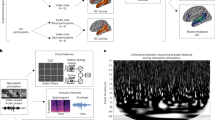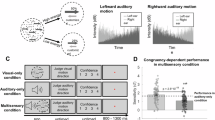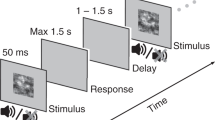Abstract
Detecting targets in multisensory environments is an elemental brain function, but it is not yet known whether information from different sensory modalities is accumulated by distinct processes, and, if so, whether the processes are subject to separate decision criteria. Here we address this in two experiments (n = 22, n = 21) using a paradigm design that enables neural evidence accumulation to be traced through a centro-parietal positivity and modelled alongside response time distributions. Through analysis of both redundant (respond-to-either-modality) and conjunctive (respond-only-to-both) audio-visual detection data, joint neural–behavioural modelling, and a follow-up onset-asynchrony experiment, we found that auditory and visual evidence is accumulated in distinct processes during multisensory detection, and cumulative evidence in the two modalities sub-additively co-activates a single, thresholded motor process during redundant detection. These findings answer long-standing questions about information integration and accumulation in multisensory conditions.
This is a preview of subscription content, access via your institution
Access options
Access Nature and 54 other Nature Portfolio journals
Get Nature+, our best-value online-access subscription
$32.99 / 30 days
cancel any time
Subscribe to this journal
Receive 12 digital issues and online access to articles
$119.00 per year
only $9.92 per issue
Buy this article
- Purchase on SpringerLink
- Instant access to full article PDF
Prices may be subject to local taxes which are calculated during checkout





Similar content being viewed by others
Data availability
The data reported in this manuscript are available via OSF at https://osf.io/64d8e/.
Code availability
The MATLAB analysis code is available via OSF at https://osf.io/64d8e/.
References
Todd, J. W. Reaction to Multiple Stimuli (The Science Press, 1912).
Hershenson, M. Reaction time as a measure of intersensory facilitation. J. Exp. Psychol. 63, 289–293 (1962).
Raab, D. H. Statistical facilitation of simple reaction times. Trans. N. Y. Acad. Sci. 24, 574–590 (1962).
Smith, P. L. & Ratcliff, R. Psychology and neurobiology of simple decisions. Trends Neurosci. 27, 161–168 (2004).
Gold, J. I. & Shadlen, M. N. The neural basis of decision making. Annu. Rev. Neurosci. 30, 535–574 (2007).
Miller, J. Divided attention: evidence for coactivation with redundant signals. Cogn. Psychol. 14, 247–279 (1982).
Otto, T. U. & Mamassian, P. Multisensory decisions: the test of a race model, its logic, and power. Multisens. Res. 30, 1–24 (2017).
Mordkoff, J. T., Miller, J. & Roch, A. C. Absence of coactivation in the motor component: evidence from psychophysiological measures of target detection. J. Exp. Psychol. Hum. Percept. Perform. 22, 25–41 (1996).
Giard, M. H. & Peronnet, F. Auditory–visual integration during multimodal object recognition in humans: a behavioral and electrophysiological study. J. Cogn. Neurosci. 11, 473–490 (1999).
Miller, J., Ulrich, R. & Lamarre, Y. Locus of the redundant signal effect in bimodal divided attention: a neurophysiological analysis. Percept. Psychophys. 63, 555–562 (2001).
Molholm, S. et al. Multisensory auditory–visual interactions during early sensory processing in humans: a high-density electrical mapping study. Cogn. Brain Res. 14, 115–128 (2002).
Molholm, S., Ritter, W., Javitt, D. C. & Foxe, J. J. Multisensory visual-auditory object recognition in humans: a high-density electrical mapping study. Cereb. Cortex 14, 452–465 (2004).
Molholm, S. et al. Audio-visual multisensory integration in superior parietal lobule revealed by human intracranial recordings. J. Neurophysiol. 96, 721–729 (2006).
Martuzzi, R. et al. Multisensory interactions within human primary cortices revealed by BOLD dynamics. Cereb. Cortex 17, 1672–1679 (2007).
Sperdin, H. F., Cappe, C., Foxe, J. J. & Murray, M. M. Early, low-level auditory–somatosensory multisensory interactions impact reaction time speed. Front. Integr. Neurosci. 3, 2 (2009).
Mercier, M. R. & Cappe, C. The interplay between multisensory integration and perceptual decision making. NeuroImage 222, 116970 (2020).
Senkowski, D. & Engel, A. K. Multi-timescale neural dynamics for multisensory integration. Nat. Rev. Neurosci. 25, 625–642 (2024).
Otto, T. U. & Mamassian, P. Noise and correlations in parallel perceptual decision making. Curr. Biol. 22, 1391–1396 (2012).
Schwarz, W. A new model to explain the redundant signals effect. Percept. Psychophys. 46, 498–500 (1989).
Schwarz, W. Diffusion, superposition, and the redundant targets effect. J. Math. Psychol. 38, 504–520 (1994).
Diederich, A. Intersensory facilitation of reaction time: evaluation of counter and diffusion coactivation models. J. Math. Psychol. 39, 197–215 (1995).
Blurton, S. P., Greenlee, M. W. & Gondan, M. Multisensory processing of redundant information in go/no-go and choice responses. Atten. Percept. Psychophys. 76, 1212–1233 (2014).
Zehetleitner, M., Ratko-Dehnert, E. & Müller, H. J. Modeling violations of the race model inequality in bimodal paradigms: co-activation from decision and non-decision components. Front. Hum. Neurosci. 9, 119 (2015).
O’Connell, R. G., Dockree, P. M. & Kelly, S. P. A supramodal accumulation-to-bound signal that determines perceptual decisions in humans. Nat. Neurosci. 15, 1729–1735 (2012).
Kelly, S. P. & O’Connell, R. G. Internal and external influences on the rate of sensory evidence accumulation in the human brain. J. Neurosci. 33, 19434–19441 (2013).
Steinemann, N. A., O’Connell, R. G. & Kelly, S. P. Decisions are expedited through multiple neural adjustments spanning the sensorimotor hierarchy. Nat. Commun. 9, 3627 (2018).
Kelly, S. P., Corbett, E. A. & O’Connell, R. G. Neurocomputational mechanisms of prior-informed perceptual decision-making in humans. Nat. Hum. Behav. 5, 467–481 (2021).
O’Connell, R. G., Shadlen, M. N., Wong-Lin, K. & Kelly, S. P. Bridging neural and computational viewpoints on perceptual decision-making. Trends Neurosci. 41, 838–852 (2018).
Afacan-Seref, K., Steinemann, N. A., Blangero, A. & Kelly, S. P. Dynamic interplay of value and sensory information in high-speed decision making. Curr. Biol. 28, 795–802.e6 (2018).
Corbett, E. A., Martinez-Rodriguez, L. A., Judd, C., O'Connell, R. G. & Kelly, S. P. Multiphasic value biases in fast-paced decisions. eLife 12, e67711 (2023).
Geuzebroek, A. C., Craddock, H., O’Connell, R. G. & Kelly, S. P. Balancing true and false detection of intermittent sensory targets by adjusting the inputs to the evidence accumulation process. eLife 12, e83025 (2023).
Kelly, S. P. & O’Connell, R. G. The neural processes underlying perceptual decision-making in humans: recent progress and future directions. J. Physiol. Paris 109, 27–37 (2015).
Pfurtscheller, G. & Lopes da Silva, F. H. Event-related EEG/MEG synchronization and desynchronization: basic principles. Clin. Neurophysiol. 110, 1842–1857 (1999).
Drugowitsch, J., DeAngelis, G. C., Klier, E. M., Angelaki, D. E. & Pouget, A. Optimal multisensory decision-making in a reaction-time task. eLife 3, e03005 (2014).
Fetsch, C. R., Pouget, A., Deangelis, G. C. & Angelaki, D. E. Neural correlates of reliability-based cue weighting during multisensory integration. Nat. Neurosci. 15, 146–154 (2011).
Raposo, D., Kaufman, M. T. & Churchland, A. K. A category-free neural population supports evolving demands during decision-making. Nat. Neurosci. 17, 1784–1792 (2014).
Hou, H., Zheng, Q., Zhao, Y., Pouget, A. & Gu, Y. Neural correlates of optional multisensory decision making under time-varying reliabilities with an invariant linear probabilistic population code. Neuron 104, 1010–1021 (2019).
Oshiro, T., Angelaki, D. E. & DeAngelis, G. C. A normalization model of multisensory integration. Nat. Neurosci. 14, 775–782 (2011).
Carandini, M. & Heeger, D. J. Normalization as a canonical neural computation. Nat. Rev. Neurosci. 13, 51–62 (2011).
Townsend, J. T. & Eidels, A. Workload capacity spaces: a unified methodology for response time measures of efficiency as workload is varied. Psychon. Bull. Rev. 18, 659–681 (2011).
O'Connell, R. G. & Kelly, S. P. Neurophysiology of human perceptual decision-making. Annu. Rev. Neurosci. 44, 495–516 (2021).
Twomey, D. M., Kelly, S. P. & O'Connell, R. G. Abstract and effector-selective decision signals exhibit qualitatively distinct dynamics before delayed perceptual reports. J. Neurosci. 36, 7346–7352 (2016).
Grogan, J. P., Rhys, W., Kelly, S. P. & O'Connell, R. G. Confidence is predicted by pre- and post-choice decision signal dynamics. Imaging Neurosci. 1, 1–23 (2023).
Kiel, J. & Senkowski, D. Neural oscillations orchestrate multisensory processing. Neuroscientist 24, 609–626 (2018).
Talsma, D., Senkowski, D., Soto-Faraco, S. & Woldorff, M. G. The multifaceted interplay between attention and multisensory integration. Trends Cogn. Sci. 14, 400–410 (2010).
Shaw, L. H. et al. Operating in a multisensory context: assessing the interplay between multisensory reaction time facilitation and inter-sensory task-switching effects. Neuroscience 436, 122–138 (2020).
Mordkoff, J. T. & Yantis, S. Dividing attention between color and shape: evidence of coactivation. Percept. Psychophys. 53, 357–366 (1993).
Ulrich, R., Miller, J. & Schröter, H. Testing the race model inequality: an algorithm and computer programs. Behav. Res. Methods 39, 291–302 (2007).
Cappe, C., Thut, G., Romei, V. & Murray, M. M. Selective integration of auditory-visual looming cues by humans. Neuropsychologia 47, 1045–1052 (2009).
Krummenacher, J., Grubert, A. & Müller, H. J. Inter-trial and redundant-signals effects in visual search and discrimination tasks: separable pre-attentive and post-selective effects. Vis. Res. 50, 1382–1395 (2010).
Vrancken, L., Vermeulen, E., Germeys, F. & Verfaillie, K. Measuring facial identity and emotion integration using the redundancy gain paradigm. Atten. Percept. Psychophys. 81, 217–236 (2019).
Chandrasekaran, C., Lemus, L., Trubanova, A., Gondan, M. & Ghazanfar, A. A. Monkeys and humans share a common computation for face/voice integration. PLoS Comput. Biol. 7, e1002165 (2011).
Otto, T. U., Dassy, B. & Mamassian, P. Principles of multisensory behavior. J. Neurosci. 33, 7463–7474 (2013).
Pilly, P. K. & Seitz, A. R. What a difference a parameter makes: a psychophysical comparison of random dot motion algorithms. Vis. Res. 49, 1599–1612 (2009).
Huk, A. C. & Meister, M. L. R. Neural correlates and neural computations in posterior parietal cortex during perceptual decision-making. Front. Integr. Neurosci. 6, 86 (2012).
Boubenec, Y., Lawlor, J., Górska, U., Shamma, S. & Englitz, B. Detecting changes in dynamic and complex acoustic environments. eLife 6, e24910 (2017).
Ratcliff, R. Group reaction time distributions and an analysis of distribution statistics. Psychol. Bull. 86, 446–461 (1979).
Foxe, J. J. & Snyder, A. C. The role of alpha-band brain oscillations as a sensory suppression mechanism during selective attention. Front. Psychol. 2, 154 (2011).
Wyart, V. & Sergent, C. The phase of ongoing EEG oscillations uncovers the fine temporal structure of conscious perception. J. Neurosci. 29, 12839–12841 (2009).
Tenke, C. E. & Kayser, J. Generator localization by current source density (CSD): implications of volume conduction and field closure at intracranial and scalp resolutions. Clin. Neurophysiol. 123, 2328–2345 (2012).
Chandrasekaran, C., Blurton, S. P. & Gondan, M. Audiovisual detection at different intensities and delays. J. Math. Psychol. 91, 159–175 (2019).
Colonius, H. & Diederich, A. Formal models and quantitative measures of multisensory integration: a selective overview. Eur. J. Neurosci. 51, 1161–1178 (2017).
Norcia, A. M., Appelbaum, L. G., Ales, J. M., Cottereau, B. R. & Rossion, B. The steady-state visual evoked potential in vision research: a review. J. Vis. 15, 4 (2015).
Loughnane, G. M. et al. Target selection signals influence perceptual decisions by modulating the onset and rate of evidence accumulation. Curr. Biol. 26, 496–502 (2016).
Nunez, M. D., Gosai, A., Vandekerckhove, J. & Srinivasan, R. The latency of a visual evoked potential tracks the onset of decision making. NeuroImage 15, 93–108 (2019).
Acknowledgements
This work was supported by a Career Development Award from Science Foundation Ireland (15/CDA/3591) and a Wellcome Trust Investigator Award In Science (219572/Z/19/Z), both to S.P.K. R.G.O. was supported by a European Research Council Consolidator Grant (IndDecision 865474). J.J.F. is supported by a centre grant from the Eunice Kennedy Shriver National Institute of Child Health and Human Development (P50 HD103536). Data collection (M.G.-R.) for the supplemental experiment reported in Supplementary Fig. 2 was supported by a grant from the National Institute of Mental Health to J.J.F. (RO1 MH85322). The funders had no role in study design, data collection and analysis, decision to publish or preparation of the manuscript.
Author information
Authors and Affiliations
Contributions
J.M.E. originally conceived the study, and developed it and designed the experiments with S.P.K. J.M.E. collected and analysed the data with guidance from S.P.K. and R.G.O. J.M.E. designed the models with guidance from S.P.K. M.G.-R. and J.J.F. designed the pulsed-stimulus multisensory detection experiment reported in Supplementary Fig. 2, and M.G.-R. collected those data. J.M.E., R.G.O. and S.P.K. interpreted the results and wrote the paper, with input from M.G.-R. and J.J.F.
Corresponding authors
Ethics declarations
Competing interests
The authors declare no competing interests.
Peer review
Peer review information
Nature Human Behaviour thanks Hans Colonius, Daniel Senkowski and the other anonymous, reviewer(s) for their contribution to the peer review of this work. Peer reviewer reports are available.
Additional information
Publisher’s note Springer Nature remains neutral with regard to jurisdictional claims in published maps and institutional affiliations.
Supplementary information
Supplementary Information
Supplementary Figs. 1–4 and Table 1.
Supplementary Video 1
Demo video of stimuli for Experiment 1.
Supplementary Video 2
Demo video of stimuli for Experiment 2.
Rights and permissions
Springer Nature or its licensor (e.g. a society or other partner) holds exclusive rights to this article under a publishing agreement with the author(s) or other rightsholder(s); author self-archiving of the accepted manuscript version of this article is solely governed by the terms of such publishing agreement and applicable law.
About this article
Cite this article
Egan, J.M., Gomez-Ramirez, M., Foxe, J.J. et al. Distinct audio and visual accumulators co-activate motor preparation for multisensory detection. Nat Hum Behav (2025). https://doi.org/10.1038/s41562-025-02280-9
Received:
Accepted:
Published:
DOI: https://doi.org/10.1038/s41562-025-02280-9



